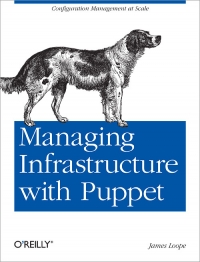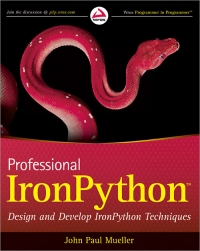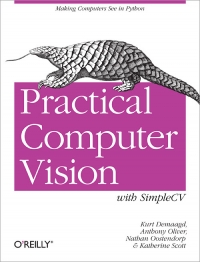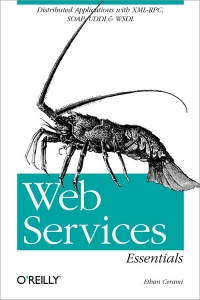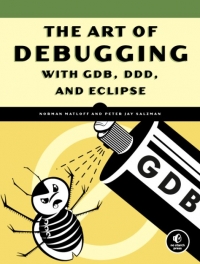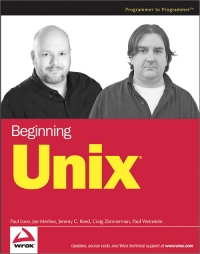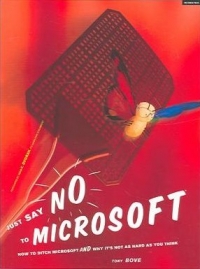Managing Infrastructure with Puppet
Get started with Puppet, and learn how this popular configuration management framework helps you automate your servers. This concise introduction shows you how to use Puppet's tools and templates to organize and execute configuration plans on Linux, Unix, and Windows servers. Through code samples and real-world examples, you'll learn how to manage pools of servers and virtual instances, and how to administer access control. If you're new to Puppet, but familiar with systems administration and Ruby language basics, this book is the ideal way to start using this open source framework. ...
Get started with Puppet, and learn how this popular configuration management framework helps you automate your servers. This concise introduction shows you how to use Puppet's tools and templates to organize and execute configuration plans on Linux, Unix, and Windows servers. Through code samples and real-world examples, you'll learn how to manage pools of servers and virtual instances, and how to administer access control. If you're new to Puppet, but familiar with systems administration and Ruby language basics, this book is the ideal way to start using this open source framework. ...
Professional IronPython
IronPython should be an important part of your developer's toolbox and this book will quickly get you up and running with this powerful language. John Paul Mueller clearly shows how IronPython can help you create better desktop or web-based applications in less time and with fewer errors. Throughout the pages, you'll find techniques for extending IronPython and making it a more robust language. In addition, you'll follow advanced steps such as building an IronPython extension that directly accesses the Win32 API. And you'll enhance your skill set as you introduce IronPython into other environments such as Linux and Mac OS X. ...
IronPython should be an important part of your developer's toolbox and this book will quickly get you up and running with this powerful language. John Paul Mueller clearly shows how IronPython can help you create better desktop or web-based applications in less time and with fewer errors. Throughout the pages, you'll find techniques for extending IronPython and making it a more robust language. In addition, you'll follow advanced steps such as building an IronPython extension that directly accesses the Win32 API. And you'll enhance your skill set as you introduce IronPython into other environments such as Linux and Mac OS X. ...
CentOS Bible
This is one of the first, if not the first comprehensive guide to the CentOS Linux operating system. First find out how to install and configure CentOS. From there, you'll cover a wealth of Linux and CentOS tools, functions, and techniques, including: how to work in the GNOME and KDE desktop environments; how to use the Linux shell, file system, and text editor; how to configure CUPS printers, Samba for file and printer sharing and other features using GUI tools; and more. ...
This is one of the first, if not the first comprehensive guide to the CentOS Linux operating system. First find out how to install and configure CentOS. From there, you'll cover a wealth of Linux and CentOS tools, functions, and techniques, including: how to work in the GNOME and KDE desktop environments; how to use the Linux shell, file system, and text editor; how to configure CUPS printers, Samba for file and printer sharing and other features using GUI tools; and more. ...
Practical Computer Vision with SimpleCV
SimpleCV is a cross platform (Windows, Macintosh, Linux) framework in Python that makes writing computer vision applications quick and easy. This book takes you through real world examples and applications using SimpleCV so that anyone, even with zero knowledge of computer vision, can use to create their own vision application in a few minutes with a webcam and PC. SimpleCV has its own integrated shell (command line) and code editor so you can rapidly test new techniques, load and run examples, view documentation, etc. The library also works with webcams, cell phones, the Xbox Kinect, and TI's Beagle Board and Panda Board. There are 1-click installers for every platform, so you can be up and running any of the examples included in this book in a few minutes. ...
SimpleCV is a cross platform (Windows, Macintosh, Linux) framework in Python that makes writing computer vision applications quick and easy. This book takes you through real world examples and applications using SimpleCV so that anyone, even with zero knowledge of computer vision, can use to create their own vision application in a few minutes with a webcam and PC. SimpleCV has its own integrated shell (command line) and code editor so you can rapidly test new techniques, load and run examples, view documentation, etc. The library also works with webcams, cell phones, the Xbox Kinect, and TI's Beagle Board and Panda Board. There are 1-click installers for every platform, so you can be up and running any of the examples included in this book in a few minutes. ...
Web Services Essentials
As a developer new to Web Services, how do you make sense of this emerging framework so you can start writing your own services today? This concise book gives programmers both a concrete introduction and a handy reference to XML web services, first by explaining the foundations of this new breed of distributed services, and then by demonstrating quick ways to create services with open-source Java tools. Web Services make it possible for diverse applications to discover each other and exchange data seamlessly via the Internet. For instance, programs written in Java and running on Solaris can find and call code written in C# that run on Windows XP, or programs written in Perl that run on Linux, without any concern about the details of how that service is implemented. A common set of Web Services is at the core of Microsoft's new .NET strategy, Sun Microsystems's Sun One Platform, and the W3C's XML Protocol Activity Group. ...
As a developer new to Web Services, how do you make sense of this emerging framework so you can start writing your own services today? This concise book gives programmers both a concrete introduction and a handy reference to XML web services, first by explaining the foundations of this new breed of distributed services, and then by demonstrating quick ways to create services with open-source Java tools. Web Services make it possible for diverse applications to discover each other and exchange data seamlessly via the Internet. For instance, programs written in Java and running on Solaris can find and call code written in C# that run on Windows XP, or programs written in Perl that run on Linux, without any concern about the details of how that service is implemented. A common set of Web Services is at the core of Microsoft's new .NET strategy, Sun Microsystems's Sun One Platform, and the W3C's XML Protocol Activity Group. ...
Getting Started with Raspberry Pi
What can you do with the Raspberry Pi, a $35 computer the size of a credit card? All sorts of things! If you're learning how to program, or looking to build new electronic projects, this hands-on guide will show you just how valuable this flexible little platform can be. This book takes you step-by-step through many fun and educational possibilities. Take advantage of several preloaded programming languages. Use the Raspberry Pi with Arduino. Create Internet-connected projects. Play with multimedia. With Raspberry Pi, you can do all of this and more. ...
What can you do with the Raspberry Pi, a $35 computer the size of a credit card? All sorts of things! If you're learning how to program, or looking to build new electronic projects, this hands-on guide will show you just how valuable this flexible little platform can be. This book takes you step-by-step through many fun and educational possibilities. Take advantage of several preloaded programming languages. Use the Raspberry Pi with Arduino. Create Internet-connected projects. Play with multimedia. With Raspberry Pi, you can do all of this and more. ...
The Art of Debugging
Debugging is crucial to successful software development, but even many experienced programmers find it challenging. Sophisticated debugging tools are available, yet it may be difficult to determine which features are useful in which situations. The Art of Debugging is your guide to making the debugging process more efficient and effective. The Art of Debugging illustrates the use three of the most popular debugging tools on Linux/Unix platforms: GDB, DDD, and Eclipse. The text-command based GDB (the GNU Project Debugger) is included with most distributions. DDD is a popular GUI front end for GDB, while Eclipse provides a complete integrated development environment. ...
Debugging is crucial to successful software development, but even many experienced programmers find it challenging. Sophisticated debugging tools are available, yet it may be difficult to determine which features are useful in which situations. The Art of Debugging is your guide to making the debugging process more efficient and effective. The Art of Debugging illustrates the use three of the most popular debugging tools on Linux/Unix platforms: GDB, DDD, and Eclipse. The text-command based GDB (the GNU Project Debugger) is included with most distributions. DDD is a popular GUI front end for GDB, while Eclipse provides a complete integrated development environment. ...
The Book of Xen
Xen, the open source virtualization tool, is a system administrator's dream. Xen is a free, high-performance virtual machine monitor that lets you consolidate your hardware and finally put those unused cycles to use - without sacrificing reliability, performance, or scalability. The Book of Xen explains everything you need to know in order to use Xen effectively, including installation, networking, memory management, and virtualized storage. You'll also learn how to use Xen and standard Linux tools to take snapshot backups, perform QoS operations on network traffic, and limit over-aggressive disk users. ...
Xen, the open source virtualization tool, is a system administrator's dream. Xen is a free, high-performance virtual machine monitor that lets you consolidate your hardware and finally put those unused cycles to use - without sacrificing reliability, performance, or scalability. The Book of Xen explains everything you need to know in order to use Xen effectively, including installation, networking, memory management, and virtualized storage. You'll also learn how to use Xen and standard Linux tools to take snapshot backups, perform QoS operations on network traffic, and limit over-aggressive disk users. ...
Beginning Unix
The Unix operating system is the basis for some of today's most-used platforms, including Mac OS X and Linux. This book covers Unix basics for these as well as the more commonly recognized Sun Solaris and BSD. First, you will learn Unix terminology, core concepts, methodology, and how to log in and out. You'll progress to customizing your work environment and learning commands. Then you'll be ready to learn to manage processes, handle security, automate tasks with shell scripting in Perl, install Unix programs, and back up your data. ...
The Unix operating system is the basis for some of today's most-used platforms, including Mac OS X and Linux. This book covers Unix basics for these as well as the more commonly recognized Sun Solaris and BSD. First, you will learn Unix terminology, core concepts, methodology, and how to log in and out. You'll progress to customizing your work environment and learning commands. Then you'll be ready to learn to manage processes, handle security, automate tasks with shell scripting in Perl, install Unix programs, and back up your data. ...
Just Say No to Microsoft
Just Say No to Microsoft - begins by tracing Microsoft's rise from tiny software startup to monopolistic juggernaut and explains how the company's practices over the years have discouraged innovation, stunted competition, and helped foster an environment ripe for viruses, bugs, and hackers. Readers learn how they can dump Microsoft products - even the Windows operating system - and continue to be productive. The book also shows how to work successfully and seamlessly with computers and people who are still hooked on Microsoft software. Includes full explanations of alternate operating systems, such as Linux and Mac, and outlines various software applications that can replace the familiar Microsoft products. ...
Just Say No to Microsoft - begins by tracing Microsoft's rise from tiny software startup to monopolistic juggernaut and explains how the company's practices over the years have discouraged innovation, stunted competition, and helped foster an environment ripe for viruses, bugs, and hackers. Readers learn how they can dump Microsoft products - even the Windows operating system - and continue to be productive. The book also shows how to work successfully and seamlessly with computers and people who are still hooked on Microsoft software. Includes full explanations of alternate operating systems, such as Linux and Mac, and outlines various software applications that can replace the familiar Microsoft products. ...
